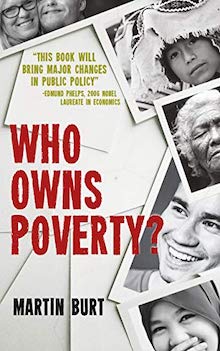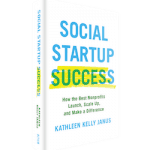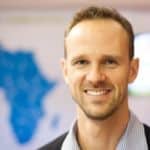Who Owns Poverty?: A Q&A with Fundación Paraguaya Founder and CEO Martin Burt
There are plenty of organizations and initiatives – public and private, for-profit and non-profit – focused on alleviating poverty and its complex effects. But despite some encouraging successes, the challenges of poverty persist. Why do so many anti-poverty efforts fail? And what should we do differently?
In his new book, Martin Burt suggests we ask a different question: Who owns poverty? (In fact, that question serves as the title of the book.) In it, he explores what happens when you examine poverty from the viewpoint of the real experts: poor families themselves. As Burt puts it, this perspective “challenges everything we thought we knew about what poverty is, and what we can do about it.”
The book includes lessons from Burt’s 34 years of experience as founder and CEO of Fundación Paraguaya, a social enterprise that promotes entrepreneurship and economic empowerment as tools for poverty alleviation. We discuss some of these insights in the interview below. NextBillion readers can get 40% off the paperback price of “Who Owns Poverty” with the discount code: NEXTBPB. We’ll also be giving away a free chapter in our weekly newsletter, NextBillion Notes, all month. And new subscribers to the newsletter can get the entire book for free as an e-book – you’ll receive an email with the appropriate URL after subscribing. (The above offers are available for one use per person, and are active from Sept. 5 to Oct. 2).
James Militzer: Why did you decide to write “Who Owns Poverty” – and what’s the meaning of the title?

Martin Burt
Martin Burt: Like many people, I am frustrated with how governments approach poverty in a top-down manner. In the best of cases they only aspire to either reduce or alleviate poverty through capital investment or social welfare programs, but they never seek poverty elimination once and for all. They simply think it is not possible.
We need a new approach. I believe that all human beings, no matter how poor, can lift themselves out of poverty in the short term through self-help, encouragement, mentoring and compassionate support. I believe in self-reliance as a liberating experience for everyone involved. After all, we are all poor in some ways and rich in others: This common vulnerability should allow us to dispense with unhelpful terms, like “the haves and have-nots.” Winning the war against global poverty requires us to discover that we are all together in this quest.
The title of “Who Owns Poverty” tries to challenge the paradox involved in the current paradigm embedded in most anti-poverty programs. Typically, these programs have a lofty declaration that states that because freedom from poverty is a fundamental human right and a public good, the state is the main duty-bearer in protecting the rights of the poor. However, the poor are not allowed to participate in the definition of poverty, and they have been relegated to a non-speaking part in someone else’s narrative about their lives. They are passive recipients of someone else’s poverty definition, someone else’s poverty measurement. As a consequence of this, poor people are also locked out of the room where decisions get made about what our poverty solutions look like, unable to articulate their perspectives and priorities. Poverty needs to be devolved to the poor if the war against poverty is to be won, and dignity is to be restored.
JM: You write in the book that “the way we define poverty makes it too complex to solve.” Can you explain what you mean by that, and what the alternative is to the current definition?
MB: The poor are being excluded from defining what poverty is, how it should be measured, and by whom. So-called “experts” have defined “sustainable development goals” such as poverty, hunger, health, education, gender, water and so forth as purely “structural” problems in a way that excludes the poor from participating in the solution. A person’s poverty is partly, or even wholly, defined as subject to forces beyond their control. That negates the efficacy of any individual’s effort in overcoming that poverty. One person might, if he or she were living in poverty, be able to increase their income, but they have zero influence over structural factors that mitigate their ability to improve their life and livelihood, such as trade distortions in global agricultural markets, their country’s resilience to climatic events and respect for the rule of law, or whether the Ministry of Health provides adequate funding for their local hospital.
This leaves little room within the current paradigm for a poor person to have any agency over most of the factors that create their poverty. It’s too big and too difficult to influence. That means reliance on external solution-providers is baked in by design. This must change. We have to ask the poor what it means for them not to be poor, and include them in the design process of anti-poverty programs. It is not difficult for them to offer guidance, as everyone knows where the shoe pinches when they walk in it every day.
JM: Can you summarize the discrepancy between the way many people in the global North (including many poverty experts) think of a “poor person,” and the reality you’ve witnessed in your work with microentrepreneurs in Fundación Paraguaya? Why are those misperceptions so important to overcome?
MB: Experts like to define poverty in monetary terms: That is, poverty is simply insufficient money. They do this so their statistical analyses and comparisons work. However, this is too reductionist and prevents the solution of the problem. They don’t consider the joy, generosity, creativity, problem-solving and entrepreneurial spirit one sees on the ground. Microentrepreneurs are so much more than simply a binary classification of poor versus non-poor. Their lives are bigger than whether they live on $1 per day or $2 per day. These labels seem all the more reductionist when applied to two people who earn the same amount of money, but whose individual experiences of poverty differ completely from each other.
That’s why, in consultation with our microfinance clients, who are the real experts, we developed the Poverty Stoplight. It is a completely new poverty measurement tool and coaching methodology. It allows poor families, using a visual survey on a tablet with pictures and the colors red, yellow and green, to self-diagnose their level of poverty across 50 indicators in six dimensions. These dimensions are income and employment, health and environment, education and culture, housing and infrastructure, organization and participation, and interiority and motivation. Poor families construct a dashboard instead of an aggregated index, and they develop a customized plan called a Life Map to take stock of their strengths and to overcome their deprivations according to their priorities. This is revolutionary.
The Poverty Stoplight also helps existing government and private sector programs increase their impact to eliminate multidimensional poverty. It works with all types of families, income-poor and not poor, and has a focus on the household. It works by activating the agency and self-efficacy of families. Families using the tool are supported by mentors and/or social workers. They also collaborate to exchange experiences and best practices to create economies of scale, to motivate each other for better results, and to leverage existing resources provided by the public sector, private companies and NGOs.
JM: Describe the way a typical anti-poverty program is designed, and contrast this to the way a program could or should be designed, if it took the views and insights of the poor into account from the beginning.
MB: Typically, poverty data is extracted from census data or is collected from local bureaucrats rather than directly from families and communities. When on the few occasions governments send their enumerators to see how people live at the village or slum level, they rarely really consult. Armed with their clipboards, they go about extracting pre-defined data points about the lives and livelihoods of poor people. Then they return to their head office to aggregate the data into a spreadsheet to create an index.
 Policy makers at the top think that they are the only decision-makers in the world. They forget that poor people at the bottom of the pyramid are equally important decision-makers solving difficult problems related to their family’s well-being on a daily basis. As a result – along with having no input on what’s being measured, how and when – poor people have no access to information collected about their lives, and no control over what gets done with it, or by whom.
Policy makers at the top think that they are the only decision-makers in the world. They forget that poor people at the bottom of the pyramid are equally important decision-makers solving difficult problems related to their family’s well-being on a daily basis. As a result – along with having no input on what’s being measured, how and when – poor people have no access to information collected about their lives, and no control over what gets done with it, or by whom.
In contrast, to be effective anti-poverty programs must be shaped by the perspectives and priorities of poor people themselves. That understanding should include many aspects of their poverty beyond just lack of money, some of which will invariably be subjective. Yet we don’t need to worry about whether it’s too difficult for us to measure these things, or too impolite to ask about sensitive topics, because it’s not us who should be doing the asking and the measuring: It’s the poor people themselves.
When poor people are allowed to ask themselves difficult questions, unexpected things happen.
The first of these is that people typically look at their lives in a new way; they count their blessings, take stock of their challenges and have a clear vision of what’s possible. They envision what it looks like to be non-poor in each aspect of their lives. People have to be allowed to be poor and rich at the same time in different ways.
To help poor families to make meaning out of their poverty information, we must not reduce the richness of multidimensional information into a single index, percentage or poverty score. Poverty indices that aggregate poverty data in this way may be useful for policymakers—but the way we define “poverty” must be framed not by program budgets or outputs but by outcomes, from the perspective of the family that owns it: “We are a family that saves. We are a family that has adequate clothing and nutritious food. We are a family that could do a bit better at keeping a family budget.”
JM: You write that “Time and again, we have seen poor families devising solutions to problems we previously considered intractable … [yet] rarely, if ever, do poverty experts consider poor people as equally important decision-makers.” Can you share an example of a problem solved by poor people themselves, and what anti-poverty organizations can learn from it?
MB: When we developed the Poverty Stoplight, we soon realized that serving people living in poverty wasn’t about us convincing them what their problems were. They knew perfectly well. It was about motivation and skills. It was about answering “yes” to two questions: “Is it worth it?” and “Can I do it?” Once people were allowed to define their problems and set their priorities, it was a matter of activating different sources of influence at the personal, collective and structural level.
For example, on one occasion, in order to promote positive peer pressure and group support at the community level, the families with whom we were working suggested that we hold competitions with prizes for those who succeeded in different challenges, such as fixing their toilets, their kitchens, their teeth or their overweight. We were told that for people to overcome their poverty, we had to help them love to do what they hated, we had to make it fun. We thus turned to gamification to transform poverty elimination into a competitive sport. We now have a dozen client poverty-elimination campaigns, all of which use social media to create buzz around each challenge.
In our “My Bathroom, My Kitchen, My Pride” competition, our microfinance clients submit “before and after” photos of either their remodeled bathroom or kitchen. Then a staff jury chooses 24 finalists to compete for public votes in an online survey via Facebook. The winners in different categories get a cash prize of $530, as well as $1,800 to the village banking group whose member wins the competition (thus creating peer support for individual achievement). In 2017, this led participants to oversee the construction of 752 new bathrooms and kitchens. We ran a similar competition, called “My Happy Smile,” in which clients competed for “most improved smile” after fixing their teeth.
The beauty of these types of events is that we, as a microfinance program, can influence massive amounts of positive change for very little investment. For instance, in the case of the bathrooms and kitchen competition, our financial outlay was $4,660: $530 each for the two winners in two categories (bathroom and kitchen) and $1,800 for each of their village banks. That meant our per-unit investment was about $6 each—aside from the incalculable “nudging” value of getting over 11,000 people involved in a virtual conversation about the importance of having a modern bathroom or kitchen. That same year, we also influenced 96 people to get their teeth fixed, 360 families to work together on local environmental clean-ups, 465 clients to lose weight, 698 women to encourage their friends to go to their local clinic for pap smears and 204 new client self-help groups to form.
JM: Realistically, what do you think global anti-poverty efforts will look like in 10 years? Will they be essentially similar to the models we have now, or will they be much more aligned with the vision you’ve outlined in your book? In short: Are you optimistic, pessimistic (or undecided) about the future of the fight against poverty (and why)?
MB: I think that monetary poverty, based on per capita income, will continue to fall in the world, as it has been going down in my own country Paraguay, as well as in China, Brazil, and many other countries. However, as we accomplish this the goal posts will move. People will start demanding that poverty be considered multi-dimensional, not just income-related. I also think that inequality will become a grave policy concern. People feel that there is too much concentration of wealth, and that traditional income distribution measures such as health, education and housing are not fulfilling their promise. Today most people are poor based on the zip code in which they are born.
Nevertheless I am optimistic, and I think that technology can be our new ally, as it will force old paradigms to fall by the wayside. It will allow a more diverse set of voices in the spaces where current anti-poverty debates are held and decisions are made. Technology already is affecting every aspect of our lives: the ways in which we live, work and play; the ways in which we collaborate; the ways in which we hold our leaders accountable. So, too, technology can allow us to design new poverty-elimination programs that are powered by the insights of the real experts on poverty: not the people sitting in the boardroom but the people living in the slums and in the villages. We will see new anti-poverty programs that facilitate poverty elimination by the people and for the people. We need only two things to achieve a radical vision for total and lasting global poverty elimination: a belief in the power of audacious questions, and the humility to embrace the answers we find when we ask them.
To date, we have behaved as though we own other people’s poverty: We set the intellectual agenda, we define the problems, we build the measurement and tracking tools, we design the programs, we raise the money and we report back to our funders on our impact. In the coming years, we will see that when poor people own their own poverty and the responsibility for eliminating it – and when theirs is the most important voice in the poverty-elimination process –then the role, aims and efforts of development organizations are bound to change.
I’m not suggesting that, by helping families to own their poverty, we should abandon our responsibility toward poor families. Nor I am suggesting we place the burden of overcoming poverty entirely on their shoulders. But we will be called upon to work in new ways, to collaborate in new ways and to interact with families in new ways. And when poor families start articulating their needs and demanding change, we’d better be ready to respond—in a manner which fully respects their agency, their authority and their self-efficacy.
The most radical future I can see for the development sector is one that has zero agenda, zero thematic focus and zero mission—other than to facilitate the changes defined by poor families and communities. Imagine what would happen if an organization showed up with nothing but two questions: “What do you need?” and “How can we help you make that happen?” Our work would then focus on connecting individual families to existing solutions and supporting them in identifying new ones. If this is not poverty elimination of poor families, by poor families, and for poor families, then I don’t know what is.
James Militzer is an editor at NextBillion.
Photo courtesy of Patrick Hendry.
- Categories
- Finance, Social Enterprise



